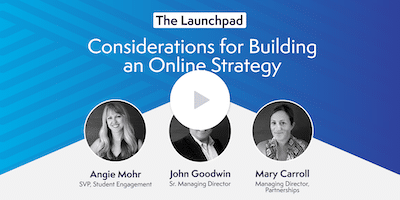Navigating the Crossroads of Tradition and Modern Market Dynamics
Colleges and universities have a long history of helping students transform their lives. But tradition shouldn’t lead to stagnation — especially as the value of higher education is increasingly scrutinized and online search engines offer more insight into competitive programs than ever before. Prospective students now approach higher education opportunities with the savvy and skepticism of seasoned buyers.
Thinking of students as “buyers” or “consumers” is a concept that might make academia squirm.
But in a world overflowing with choices and information, institutions should adapt to the changes and evolve to see prospective students as customers. In this article, we’re going to:
- Explore factors that influence buyer psychology in higher education
- Reveal strategies and tactics to convert prospective students into committed enrollees
- Discover the power of personalization and its role in enhancing the higher ed experience
What Is Buyer Behavior?
Buyer behavior in higher education refers to the decision-making processes and actions of prospective students and their influencers as they evaluate, select, and commit to an educational institution.
While the term “buyer” is traditionally associated with commerce, in this context, it signifies the transactional nature of selecting a higher ed program: an exchange of tuition and commitment for an education, an experience, and a degree.
Prospective Students Are Buyers
The pursuit of higher education is a significant milestone. As prospective students navigate this pivotal moment, they aren’t just selecting an institution — they’re investing in their future.
Much like in their other buying experiences, they consider a wide range of factors before making their choice. Recognizing this shift from passive applicant to active consumer offers institutions a clearer perspective on how to approach buyer psychology to engage and ultimately enroll students.
Emotions: The Heart of the Decision
We buy on-trend clothes to feel comfortable and reflect our personalities. We buy comfort food to combat stress and indulge in nostalgia. We buy homes to create stability and harmony in our lives.
The “purchase” of higher education is rooted in a similar, deeply personal place. Conversions are driven by more than logic and pragmatism; they’re charged by emotions. Higher ed institutions should consider the following drivers of students’ decisions:
- Institutional brand: Do the institution’s ethos, culture, and values align with those of the student? Does it offer a sense of belonging or promise a transformative experience?
- Personal development: Students’ emotional drivers extend beyond a sense of community. They can be aspirational, such as career mobility, personal growth, or the chance to make a difference in the world.
Institutions should craft enrollment messages that evoke and amplify positive sentiments related to these decision drivers.
Information: The Digital Storefront
Before connecting with potential students’ emotions, institutions must first lay the foundation for a buying decision to be made. In our digital age, every click, every web page, and every program review matters in buyer psychology. Prospective students expect:
- Seamless online experiences: University websites should contain comprehensive, easy-to-navigate information.
- Transparency: From course details to faculty qualifications and, yes, tuition costs, being upfront and clear is crucial.
Influence: The Power of Testimony
Brand strength in higher ed is built on credibility, and nothing speaks louder than the experiences of those who’ve graduated from an institution.
Telling the stories of current students and successful alumni can create a compelling narrative, showing both the journey and the potential destination. These authentic stories serve as powerful endorsements, fostering trust and aspiration in potential students.
Finances: The Pragmatic Consideration
While passion and aspiration drive many toward higher education, financial considerations are undoubtedly important and are often a determining factor in program selection.
Offering clear communication about the entire financial investment is essential. This means tuition costs, but also available financial aid, scholarships, and potential earnings after graduation. Data from Onward — Archer Education’s proprietary student engagement platform — shows us that prospective students are highly interested in the financial aid and tuition sections of our digital experiences.
By providing a realistic picture of their programs’ potential return on investment, institutions can address an important aspect of buyer psychology and help students navigate this often-daunting step in their decision-making journey.
Strategies for Better Conversations and Faster Conversions
Now that we’ve covered the core pieces of buyer psychology and how they apply to higher ed, let’s talk about strategies to engage prospective students effectively and expedite their selection process.
Personalized Communication: The Key to Connection
Personalization is the key to building a meaningful virtual connection. Data-driven insight from the Onward platform tailors communication with each individual student based on their preferences and interests. No two students follow the same path (nor should an institution’s personalization efforts, but that’s another article).
Transparency and Trust: The Cornerstones of Decision-Making
Trust is rooted in transparency. That includes providing clear information on tuition, program offerings, flexibility, modalities, and expectations. Onward data demonstrates that when an institution can answer a prospective student’s top five questions about a program — outcomes, time commitment, cost, how to pay, and how to apply — the student is significantly more likely to start the application process.
When institutions address students’ (buyers’) questions right away, they create a sense of trust in their institution, and students are more likely to engage in the conversations that lead to a program decision.
Engagement: Beyond the Acceptance Letter
The student journey doesn’t end at enrollment. The modern institution needs to keep students engaged through ongoing communication that builds on initial conversations. Happy, engaged students are more likely to persist in their journey.
The Right Kind of Tech: Meeting Modern Expectations
Today’s students are digital natives. They are accustomed to swift, intuitive digital interactions, whether it’s via chatbots, enrollment platforms, or personalized communication tools like Onward. The right technological tools not only facilitate easier communication but also reflect an institution’s commitment to offering a modern, student-centric experience — which can often make or break a buying decision.
Initiate Better Conversations With Buyers
It’s never been easier for universities to engage with students where they are. Using emotional connections, accessibility, and information, universities can put students in the driver’s seat to make their educational choices.
Higher education exists to foster growth, promote discovery, and inspire future generations. Will your institution embrace that ideology and adapt your marketing efforts to address modern buyer psychology?
At Archer Education, we help colleges and universities increase enrollment and retention with marketing strategies that emphasize personalized communication, transparency, and emotional engagement. Contact us today to discuss how we can usher your institution into the modern age.



